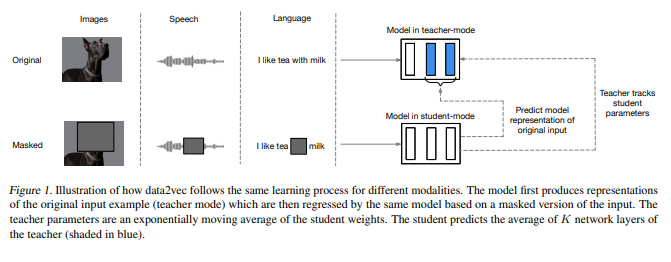File size: 4,500 Bytes
abbaedb cbbe332 abbaedb eb17ab7 abbaedb eb17ab7 abbaedb bc45eb4 f20d8d7 |
1 2 3 4 5 6 7 8 9 10 11 12 13 14 15 16 17 18 19 20 21 22 23 24 25 26 27 28 29 30 31 32 33 34 35 36 37 38 39 40 41 42 43 44 45 46 47 48 49 50 51 52 53 54 55 56 57 58 59 60 61 62 63 64 65 66 67 68 69 70 71 72 73 74 75 76 77 78 79 80 81 82 83 84 85 86 87 88 89 90 91 92 93 94 95 96 97 98 99 100 101 102 103 104 105 106 107 108 109 110 111 112 113 114 115 116 117 |
---
language: en
datasets:
- librispeech_asr
tags:
- speech
- hf-asr-leaderboard
license: apache-2.0
widget:
- example_title: Librispeech sample 1
src: https://cdn-media.huggingface.co/speech_samples/sample1.flac
- example_title: Librispeech sample 2
src: https://cdn-media.huggingface.co/speech_samples/sample2.flac
model-index:
- name: data2vec-audio-base-960h
results:
- task:
name: Automatic Speech Recognition
type: automatic-speech-recognition
dataset:
name: Librispeech (clean)
type: librispeech_asr
args: en
metrics:
- name: Test WER
type: wer
value: 2.8
---
# Data2Vec-Audio-Base-960h
[Facebook's Data2Vec](https://ai.facebook.com/research/data2vec-a-general-framework-for-self-supervised-learning-in-speech-vision-and-language/)
The base model pretrained and fine-tuned on 960 hours of Librispeech on 16kHz sampled speech audio. When using the model
make sure that your speech input is also sampled at 16Khz.
[Paper](https://arxiv.org/abs/2202.03555)
Authors: Alexei Baevski, Wei-Ning Hsu, Qiantong Xu, Arun Babu, Jiatao Gu, Michael Auli
**Abstract**
While the general idea of self-supervised learning is identical across modalities, the actual algorithms and objectives differ widely because they were developed with a single modality in mind. To get us closer to general self-supervised learning, we present data2vec, a framework that uses the same learning method for either speech, NLP or computer vision. The core idea is to predict latent representations of the full input data based on a masked view of the input in a self-distillation setup using a standard Transformer architecture. Instead of predicting modality-specific targets such as words, visual tokens or units of human speech which are local in nature, data2vec predicts contextualized latent representations that contain information from the entire input. Experiments on the major benchmarks of speech recognition, image classification, and natural language understanding demonstrate a new state of the art or competitive performance to predominant approaches.
The original model can be found under https://github.com/pytorch/fairseq/tree/main/examples/data2vec .
# Pre-Training method

For more information, please take a look at the [official paper](https://arxiv.org/abs/2202.03555).
# Usage
To transcribe audio files the model can be used as a standalone acoustic model as follows:
```python
from transformers import Wav2Vec2Processor, Data2VecForCTC
from datasets import load_dataset
import torch
# load model and processor
processor = Wav2Vec2Processor.from_pretrained("facebook/data2vec-audio-base-960h")
model = Data2VecForCTC.from_pretrained("facebook/data2vec-audio-base-960h")
# load dummy dataset and read soundfiles
ds = load_dataset("patrickvonplaten/librispeech_asr_dummy", "clean", split="validation")
# tokenize
input_values = processor(ds[0]["audio"]["array"],, return_tensors="pt", padding="longest").input_values # Batch size 1
# retrieve logits
logits = model(input_values).logits
# take argmax and decode
predicted_ids = torch.argmax(logits, dim=-1)
transcription = processor.batch_decode(predicted_ids)
```
## Evaluation
This code snippet shows how to evaluate **facebook/data2vec-audio-base-960h** on LibriSpeech's "clean" and "other" test data.
```python
from transformers import Wav2Vec2Processor, Data2VecForCTC
from datasets import load_dataset
import torch
from jiwer import wer
# load model and processor
processor = Wav2Vec2Processor.from_pretrained("facebook/data2vec-audio-base-960h").to("cuda")
model = Data2VecForCTC.from_pretrained("facebook/data2vec-audio-base-960h")
librispeech_eval = load_dataset("librispeech_asr", "clean", split="test")
def map_to_pred(batch):
input_values = processor(batch["audio"]["array"], return_tensors="pt", padding="longest").input_values
with torch.no_grad():
logits = model(input_values.to("cuda")).logits
predicted_ids = torch.argmax(logits, dim=-1)
transcription = processor.batch_decode(predicted_ids)
batch["transcription"] = transcription
return batch
result = librispeech_eval.map(map_to_pred, batched=True, batch_size=1, remove_columns=["audio"])
print("WER:", wer(result["text"], result["transcription"]))
```
*Result (WER)*:
| "clean" | "other" |
|---|---|
| 2.77 | 7.08 | |